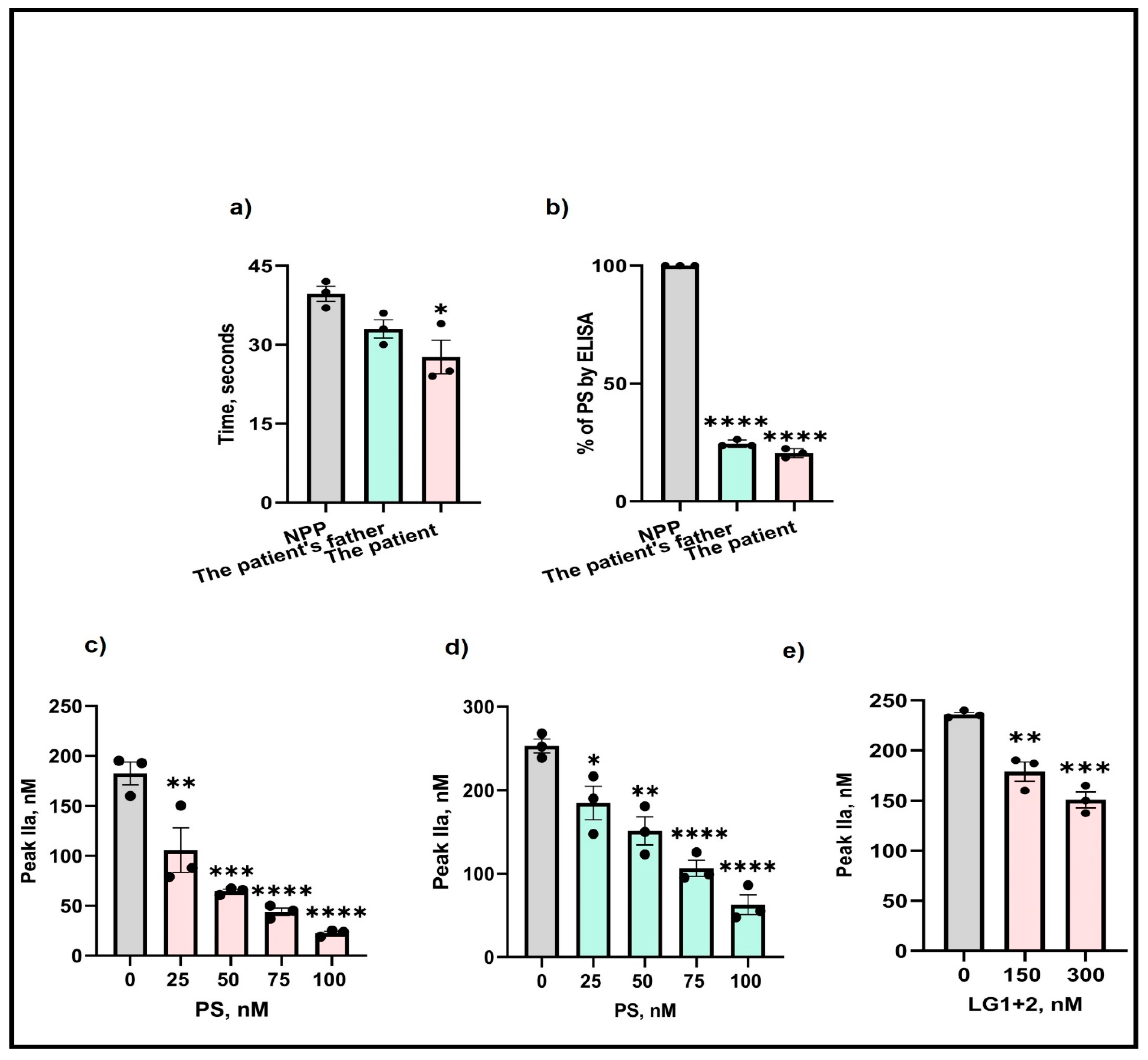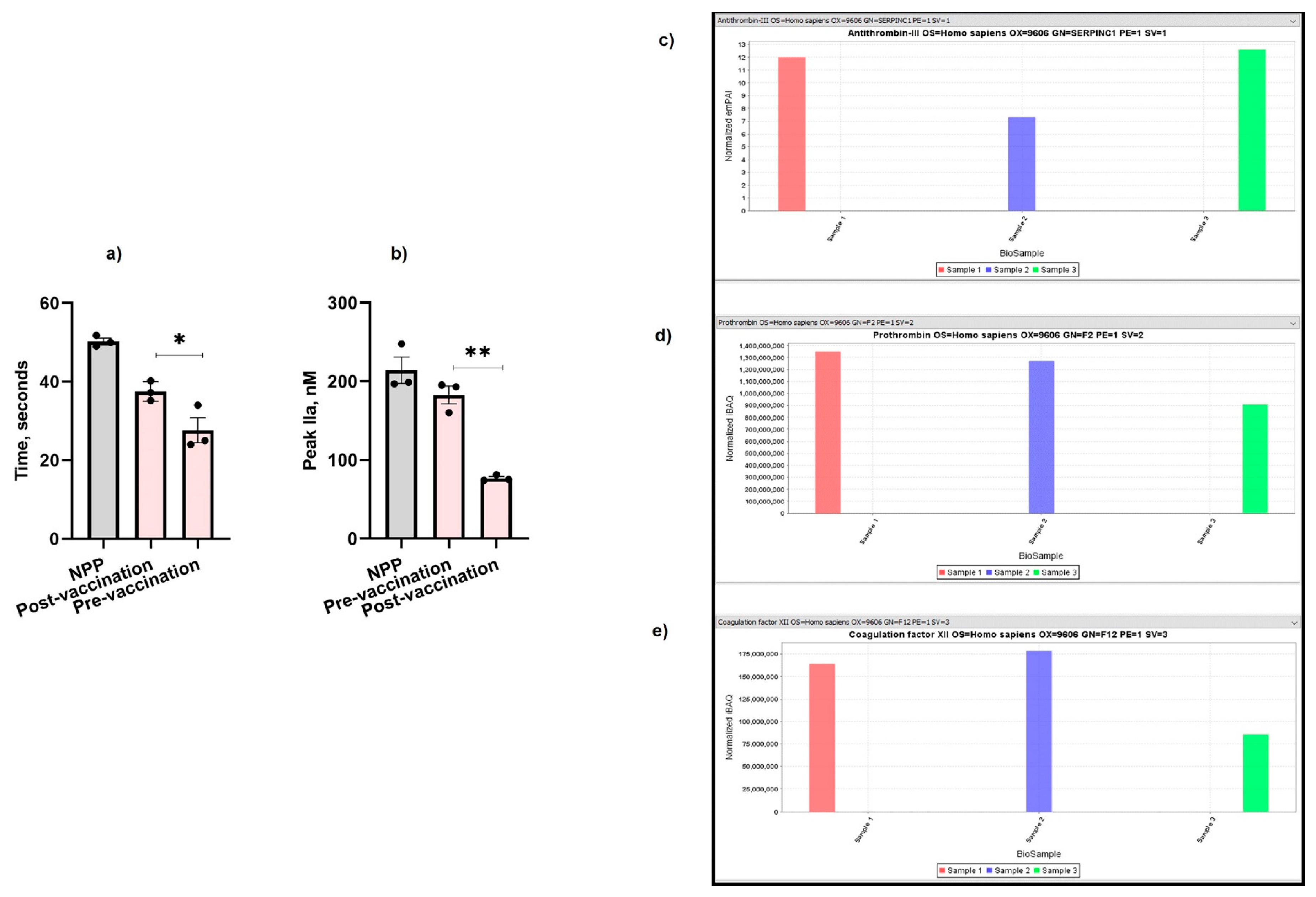SARS-CoV-2 Vaccine Improved Hemostasis of a Patient with Protein S Deficiency: A Case Report
Abstract
1. Introduction
2. Case Presentation
3. Discussion
Author Contributions
Funding
Institutional Review Board Statement
Informed Consent Statement
Data Availability Statement
Acknowledgments
Conflicts of Interest
References
- Lane, D.A.; Philippou, H.; Huntington, J.A. Directing thrombin. Blood 2005, 106, 2605–2612. [Google Scholar] [CrossRef]
- Rodriguez, V.; Warad, D. Pediatric Coagulation Disorders. Pediatr. Rev. 2016, 37, 279–291. [Google Scholar] [CrossRef] [PubMed]
- Walker, F.J. Regulation of activated protein C by protein S. The role of phospholipid in factor Va inactivation. J. Biol. Chem. 1981, 256, 11128–11131. [Google Scholar] [CrossRef]
- Hackeng, T.M.; Sere, K.M.; Tans, G.; Rosing, J. Protein S stimulates inhibition of the tissue factor pathway by tissue factor pathway inhibitor. Proc. Natl. Acad. Sci. USA 2006, 103, 3106–3111. [Google Scholar] [CrossRef]
- Chattopadhyay, R.; Sengupta, T.; Majumder, R. Inhibition of intrinsic Xase by protein S: A novel regulatory role of protein S independent of activated protein C. Arterioscler. Thromb. Vasc. Biol. 2012, 32, 2387–2393. [Google Scholar] [CrossRef]
- Burstyn-Cohen, T.; Heeb, M.J.; Lemke, G. Lack of protein S in mice causes embryonic lethal coagulopathy and vascular dysgenesis. J. Clin. Investig. 2009, 119, 2942–2953. [Google Scholar] [CrossRef] [PubMed]
- Majumder, R.; Nguyen, T. Protein S: Function, regulation, and clinical perspectives. Curr. Opin. Hematol. 2021, 28, 339–344. [Google Scholar] [CrossRef]
- Sim, M.M.S.; Wood, J.P. Dysregulation of Protein S in COVID-19. Best. Pract. Res. Clin. Haematol. 2022, 35, 101376. [Google Scholar] [CrossRef]
- Ferrari, E.; Sartre, B.; Squara, F.; Contenti, J.; Occelli, C.; Lemoel, F.; Levraut, J.; Doyen, D.; Dellamonica, J.; Mondain, V.; et al. High Prevalence of Acquired Thrombophilia without Prognosis Value in Patients with Coronavirus Disease 2019. J. Am. Heart Assoc. 2020, 9, e017773. [Google Scholar] [CrossRef]
- Cines, D.B.; Bussel, J.B. SARS-CoV-2 Vaccine-Induced Immune Thrombotic Thrombocytopenia. N. Engl. J. Med. 2021, 384, 2254–2256. [Google Scholar] [CrossRef]
- Gomez-Mesa, J.E.; Galindo-Coral, S.; Montes, M.C.; Munoz Martin, A.J. Thrombosis and Coagulopathy in COVID-19. Curr. Probl. Cardiol. 2021, 46, 100742. [Google Scholar] [CrossRef] [PubMed]
- Kim, E.J.; Yoo, S.J. Pulmonary Embolism after Vaccination with the COVID-19 Vaccine (Pfizer, BNT162b2): A Case Report. Vaccines 2023, 11, 1075. [Google Scholar] [CrossRef] [PubMed]
- Formstone, C.J.; Wacey, A.I.; Berg, L.P.; Rahman, S.; Bevan, D.; Rowley, M.; Voke, J.; Bernardi, F.; Legnani, C.; Simioni, P.; et al. Detection and characterization of seven novel protein S (PROS) gene lesions: Evaluation of reverse transcript-polymerase chain reaction as a mutation screening strategy. Blood 1995, 86, 2632–2641. [Google Scholar] [CrossRef]
- Gupta, A.; Tun, A.M.; Gupta, K.; Tuma, F. Protein S Deficiency. In StatPearls; StatPearls: Treasure Island, FL, USA, 2024. [Google Scholar]
- Pegelow, C.H.; Ledford, M.; Young, J.N.; Zilleruelo, G. Severe protein S deficiency in a newborn. Pediatrics 1992, 89, 674–676. [Google Scholar] [CrossRef] [PubMed]
- Dogan, Y.; Aygun, D.; Yilmaz, Y.; Kanra, G.; Secmeer, G.; Besbas, N.; Gurgey, A. Severe protein S deficiency associated with heterozygous factor V Leiden mutation in a child with purpura fulminans. Pediatr. Hematol. Oncol. 2003, 20, 1–5. [Google Scholar] [CrossRef] [PubMed]
- Gandrille, S.; Borgel, D.; Sala, N.; Espinosa-Parrilla, Y.; Simmonds, R.; Rezende, S.; Lind, B.; Mannhalter, C.; Pabinger, I.; Reitsma, P.H.; et al. Protein S deficiency: A database of mutations--summary of the first update. Thromb. Haemost. 2000, 84, 918. [Google Scholar]
- Juhl, D.; Kuta, P.; Shneyder, M.; Wunsche, F.; Nowak-Gottl, U. Two Novel Variants in the Protein S Gene PROS1 Are Associated with Protein S Deficiency and Thrombophilia. Acta Haematol. 2021, 144, 222–226. [Google Scholar] [CrossRef]
- Mele, F.; Tafuri, S.; Stefanizzi, P.; Amati, D.A.; Calvano, M.; Leonardelli, M.; Macorano, E.; Duma, S.; De Gabriele, G.; Introna, F.; et al. Cerebral venous sinus thrombosis after COVID-19 vaccination and congenital deficiency of coagulation factors: Is there a correlation? Hum. Vaccin. Immunother. 2022, 18, 2095166. [Google Scholar] [CrossRef]
- Chirumamilla, Y.; Almerstani, Y.; Marcus, H.; Bachuwa, G. Protein S Deficiency and COVID-19: A Brutal Combination Leading to Acute Submassive Bilateral Pulmonary Embolism. Cureus 2023, 15, e41560. [Google Scholar] [CrossRef]
- Bekal, S.; Husari, G.; Okura, M.; Huang, C.A.; Bukari, M.S. Thrombosis Development After mRNA COVID-19 Vaccine Administration: A Case Series. Cureus 2023, 15, e41371. [Google Scholar] [CrossRef]
- Miri, C.; Bouchlarhem, A.; Boulouiz, S.; El Ouafi, N.; Bazid, Z. Pulmonary embolism with junctional tachycardia: A serious complication after COVID-19 vaccination. Ann. Med. Surg. 2022, 80, 103983. [Google Scholar] [CrossRef]
- Lemke, G.; Silverman, G.J. Blood clots and TAM receptor signalling in COVID-19 pathogenesis. Nat. Rev. Immunol. 2020, 20, 395–396. [Google Scholar] [CrossRef] [PubMed]
- Gjorgjieva, T.; Chaloemtoem, A.; Shahin, T.; Bayaraa, O.; Dieng, M.M.; Alshaikh, M.; Abdalbaqi, M.; Del Monte, J.; Begum, G.; Leonor, C.; et al. Systems genetics identifies miRNA-mediated regulation of host response in COVID-19. Hum. Genom. 2023, 17, 49. [Google Scholar] [CrossRef]
- Chen, W.C.; Hu, S.Y.; Shen, C.F.; Cheng, M.H.; Hong, J.J.; Shen, C.J.; Cheng, C.M. COVID-19 Vaccination in Pregnancy: Pilot Study for Maternal and Neonatal MicroRNA Profiles. Vaccines 2023, 11, 1814. [Google Scholar] [CrossRef]
- Talotta, R. COVID-19 mRNA vaccines as hypothetical epigenetic players: Results from an in silico analysis, considerations and perspectives. Vaccine 2023, 41, 5182–5194. [Google Scholar] [CrossRef]
- Saeed, R.H.; Abdulrahman, Z.F.A.; Mohammad, D.K. The impact of COVID-19 on microRNA and CD marker expression in AML patients. Sci. Rep. 2024, 14, 14251. [Google Scholar] [CrossRef] [PubMed]
- Gilyazova, I.; Timasheva, Y.; Karunas, A.; Kazantseva, A.; Sufianov, A.; Mashkin, A.; Korytina, G.; Wang, Y.; Gareev, I.; Khusnutdinova, E. COVID-19: Mechanisms, risk factors, genetics, non-coding RNAs and neurologic impairments. Noncoding RNA Res. 2023, 8, 240–254. [Google Scholar] [CrossRef]
- Roustai Geraylow, K.; Hemmati, R.; Kadkhoda, S.; Ghafouri-Fard, S. miRNA expression in COVID-19. Gene Rep. 2022, 28, 101641. [Google Scholar] [CrossRef]
- Tay, J.W.; Romeo, G.; Hughes, Q.W.; Baker, R.I. Micro-ribonucleic Acid 494 regulation of protein S expression. J. Thromb. Haemost. 2013, 11, 1547–1555. [Google Scholar] [CrossRef]
- Rasizadeh, R.; Aghbash, P.S.; Nahand, J.S.; Entezari-Maleki, T.; Baghi, H.B. SARS-CoV-2-associated organs failure and inflammation: A focus on the role of cellular and viral microRNAs. Virol. J. 2023, 20, 179. [Google Scholar] [CrossRef]
- Rodriguez-Rius, A.; Lopez, S.; Martinez-Perez, A.; Souto, J.C.; Soria, J.M. Identification of a Plasma MicroRNA Profile Associated With Venous Thrombosis. Arterioscler. Thromb. Vasc. Biol. 2020, 40, 1392–1399. [Google Scholar] [CrossRef] [PubMed]
- Stoichitoiu, L.E.; Pinte, L.; Balea, M.I.; Nedelcu, V.; Badea, C.; Baicus, C. Anticoagulant protein S in COVID-19: Low activity, and associated with outcome. Rom. J. Intern. Med. 2020, 58, 251–258. [Google Scholar] [CrossRef] [PubMed]
- Moatar, A.I.; Chis, A.R.; Romanescu, M.; Ciordas, P.D.; Nitusca, D.; Marian, C.; Oancea, C.; Sirbu, I.O. Plasma miR-195-5p predicts the severity of Covid-19 in hospitalized patients. Sci. Rep. 2023, 13, 13806. [Google Scholar] [CrossRef] [PubMed]
- Hasan, A.; Arefanian, H.; Channanath, A.M.; AlKhairi, I.; Cherian, P.; Devarajan, S.; Thanaraj, T.A.; Abu-Farha, M.; Abubaker, J.; Al-Mulla, F. Association of COVID-19 Vaccines ChAdOx1-S and BNT162b2 with Circulating Levels of Coagulation Factors and Antithrombin. Vaccines 2022, 10, 1226. [Google Scholar] [CrossRef]


| Name | Chr | Position | ID | Ref | Alts | VarQual | Type | Gene Symbol | Transcript | Gene Section | Nt Change | AA Change | Genotype |
|---|---|---|---|---|---|---|---|---|---|---|---|---|---|
| The patient | |||||||||||||
| 3 | 93873725 | rs9681204 | T | G | 228 | 3-prime UTR | PROS1 | NM_001314077 | Exon 16 | c.520A>C | None | GG | |
| 3 | 93877004 | rs750531364 | A | G | 222 | Missense | PROS1 | NM_001314077 | Exon 15 | c.1928T>C | M643T | AG | |
| 3 | 93886205 | rs1453447448 | T | C | 5.34 | Intron | PROS1 | NM_001314077 | Intron 12 | c.1419+131A>G | None | TC | |
| 3 | 93886282 | rs8178649 | A | G | 222 | Intron | PROS1 | NM_001314077 | Intron 12 | c.1419+54T>C | None | AG | |
| The patient’s father | |||||||||||||
| 3 | 93873725 | rs9681204 | T | G | 225 | 3-prime UTR | PROS1 | NM_001314077 | Exon 16 | c.520A>C | None | GG | |
| 3 | 93874275 | rs6123 | T | C | 222 | Synonymous | PROS1 | NM_001314077 | Exon 16 | c.2097A>G | None | TC | |
| 3 | 93877004 | rs750531364 | A | G | 222 | Missense | PROS1 | NM_001314077 | Exon 15 | c.1928T>C | M643T | AG | |
| 3 | 93886282 | rs8178649 | A | G | 228 | Intron | PROS1 | NM_001314077 | Intron 12 | c.1419+54T>C | None | GG | |
| 3 | 93896513 | . | C | CT | 44.4 | Intron indel | PROS1 | NM_001314077 | Intron 10 | c.1061+63G>G | None | REF/ALT | |
| Control 1 | |||||||||||||
| 3 | 93873725 | rs9681204 | T | G | 225 | 3-prime UTR | PROS1 | NM_001314077 | Exon 16 | c.520A>C | None | GG | |
| Control 2 | |||||||||||||
| 3 | 93873725 | rs9681204 | T | G | 228 | 3-prime UTR | PROS1 | NM_001314077 | Exon 16 | c.520A>C | None | GG | |
| 3 | 93900539 | . | C | A | 4.38 | Intron | PROS1 | NM_001314077 | Intron 8 | c.823+265G>T | None | AA |
Disclaimer/Publisher’s Note: The statements, opinions and data contained in all publications are solely those of the individual author(s) and contributor(s) and not of MDPI and/or the editor(s). MDPI and/or the editor(s) disclaim responsibility for any injury to people or property resulting from any ideas, methods, instructions or products referred to in the content. |
© 2024 by the authors. Licensee MDPI, Basel, Switzerland. This article is an open access article distributed under the terms and conditions of the Creative Commons Attribution (CC BY) license (https://creativecommons.org/licenses/by/4.0/).
Share and Cite
Mohammad, M.A.; Malik, A.; Thangada, L.; Polanía-Villanueva, D.; Zabaleta, J.; Majumder, R. SARS-CoV-2 Vaccine Improved Hemostasis of a Patient with Protein S Deficiency: A Case Report. Int. J. Mol. Sci. 2024, 25, 10717. https://doi.org/10.3390/ijms251910717
Mohammad MA, Malik A, Thangada L, Polanía-Villanueva D, Zabaleta J, Majumder R. SARS-CoV-2 Vaccine Improved Hemostasis of a Patient with Protein S Deficiency: A Case Report. International Journal of Molecular Sciences. 2024; 25(19):10717. https://doi.org/10.3390/ijms251910717
Chicago/Turabian StyleMohammad, Mohammad A., Alaa Malik, Lekha Thangada, Diana Polanía-Villanueva, Jovanny Zabaleta, and Rinku Majumder. 2024. "SARS-CoV-2 Vaccine Improved Hemostasis of a Patient with Protein S Deficiency: A Case Report" International Journal of Molecular Sciences 25, no. 19: 10717. https://doi.org/10.3390/ijms251910717
APA StyleMohammad, M. A., Malik, A., Thangada, L., Polanía-Villanueva, D., Zabaleta, J., & Majumder, R. (2024). SARS-CoV-2 Vaccine Improved Hemostasis of a Patient with Protein S Deficiency: A Case Report. International Journal of Molecular Sciences, 25(19), 10717. https://doi.org/10.3390/ijms251910717







